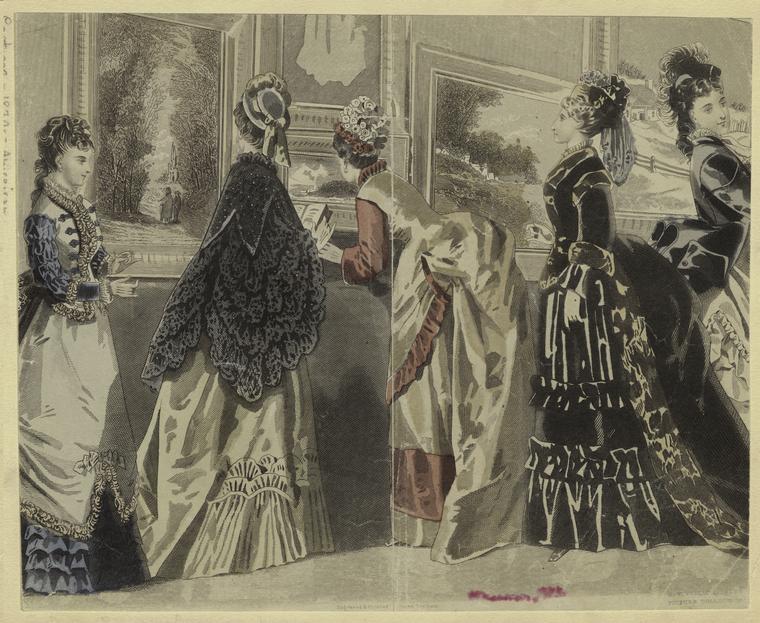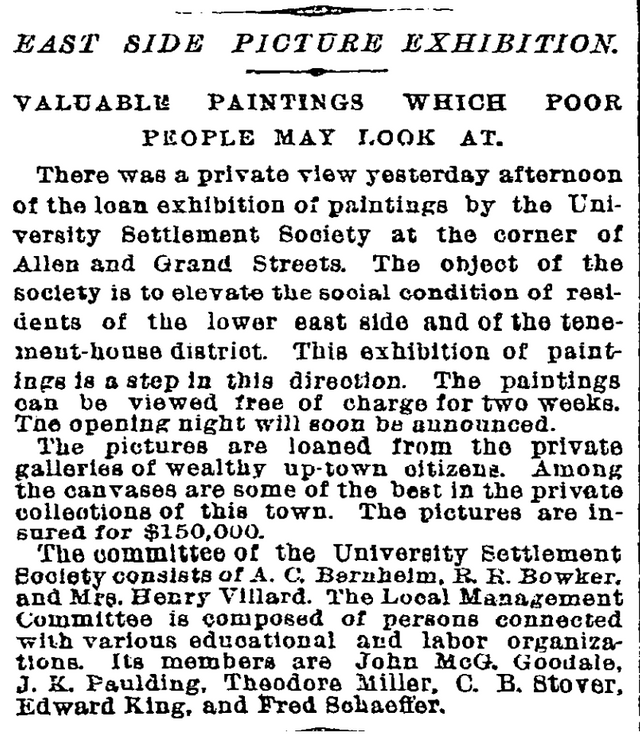Arts, Culture, and Philanthropy: The Robbed and the Robbers

Back in 1892, art exhibitions were not held for the general public. Art galleries were considered suitable only for the better classes, like art students and connoisseurs, and to this point, they charged admission and kept limited hours. So it shocked New York City when, on a hot Monday night in June, an exhibition of about 100 works of contemporary art opened its doors on Allen Street on the Lower East Side to the working people of the neighborhood- for FREE.
Suspicion on all sides
 The New York Times, June 13, 1892.
The New York Times, June 13, 1892.
Meanwhile, the labor newspapers of the city criticized the exhibition on different grounds. A prominent neighborhood socialist was noted to have objected: "The robbed and the robbers cannot sincerely fraternize, especially when the robber comes asking the robbed to accept as a favor a few crumbs from the feast which is the creation of the latter." [1]
A happy result
And yet the exhibition was a smashing success. It attracted 36,095 visitors in a forty-one day run, which in 1892 would have amounted to roughly 17% of the city's population living below Fourteenth Street. [1] The social organizations that arranged the exhibition, the East Side Art League and the University Settlement Society, continued to hold it annually for the next five years. By that time the ideals of cultural democracy had begun to spread among the leaders of New York City arts and cultural institutions.
What makes arts and culture initiatives stand out?
Nowadays thousands of organizations abound with mission statements that do not vary greatly from the aims of those early modern philanthropists: that of "interesting and instructing those to whom poverty forbids the pleasures of art." [2] What makes any of them stand out? Some might claim their longevity, others their creativity, publicity, or financial health.
The East Side Art Exhibition was not a financially sustainable venture. It was an experiment that turned out successful- even converting the neighborhood socialists if the testimony of labor activist and University Settlement Society committee member Edward King is to be believed. [1] So what made this particular idea impactful? In its limited run, it introduced new ideas, based on careful audience research, into the world of cultural philanthropy in the United States that remain valued today:
- The exhibition was open in the evenings from 7-10:30pm on weekdays, and on Sunday afternoons.
- Admission was free.
- Docents stood by to offer assistance, as if it were an uptown gallery.
- Visitors were asked to vote on their favorite paintings.
- A descriptive catalogue was distributed in both English and Hebrew to accommodate the area's residents.
Learning from the past
The East Side Art Exhibition didn't upend the social stratification of the Gilded Age. It didn't dismantle the capitalist system that made it necessary for laborers of 1892 to work an average of 60 hours a week or more to support their families. [3] It had no effect whatsoever on miserable, dangerous living or working conditions. What it did help do was humanize New York City's working people in the eyes of the wealthy, conservative, and skeptical, while treating its visitors with dignity and welcome.
I'm not sure that this is a grand enough mission for the arts and cultural nonprofits of today. It's not 1892, but this country is facing what some observers have called the "New Gilded Age". At what point will we move beyond "providing access" and "promoting education"? When will we acknowledge that the system of inequality feeds itself, and work to change it?
100% of the SBD rewards from this #explore1918 post will support the Philadelphia History Initiative @phillyhistory. This crypto-experiment conducted by graduate courses at Temple University's Center for Public History and MLA Program, is exploring history and empowering education. Click here to learn more.
Works cited
- A.C. Bernheim, “Results of Picture-Exhibitions in Lower New York,” The Forum (July 1895), 610–13.
- "The Fine Arts: The East Side Loan Exhibition," The Critic, 20 no. 540 (June 25, 1892).
- Robert Whaples, "Hours of Work in U.S. History," The Economic History Association, EH.net, https://eh.net/encyclopedia/hours-of-work-in-u-s-history/
This is a test comment, notify @kryzsec on discord if there are any errors please.
Being A SteemStem Member
This is a really great post. That newspaper article was wild. (I wonder why they mentioned how much the paintings are insured for... 🤔) It was interesting to note my own reactions as I read about this exhibition -- for example, how many of the "new ideas" you pulled out still seem new/uncommon today! How many current art museums would let you vote on your favorite paintings? How many museums have extended evening hours?
You ask when we'll move beyond "providing access" and "promoting education," but it seems to me that there are so many institutions that are still working to achieve just that. (Though this doesn't mean that institutions still shouldn't reexamine their missions and rethink who their audiences are and how they see themselves in relation to them.)
Thanks, Charlie! I pulled this from my thesis research, so it's something I am chewing on a lot of the time... and I get pretty frustrated with what seems like a hundred years worth of attempts at reinventing the wheel. You're right, but I don't have a solution to offer just yet. Maybe I'll come to one while hammering away at my thesis.
Definitely, and I can imagine how frustrating that must be to study this cycle with no one solving the issues at hand. I'm really looking forward to what conclusions (or non-conclusions?) you come to in your thesis!!
"Valuable Paintings Which Poor People May Look At" is a hilariously depressing headline. Who ok'd this headline??
Also, I just wanted to point out the extended evening hours that @charliehersh also noted. The Philadelphia Museum of Art has one day of extended evening hours, but in my limited research, I couldn't find any history centered institutions that offer after work options! Over 100 years later, and we're still working within a system that operates on an "I opened the doors, where are all the people?" mentality.
Exactly. "Why won't people take the whole day off work to come into Center City and learn about white people?!?!!" Baffling!
Very interesting example to explore and learn from. I wonder how museums today would respond to your charge that they tend toward "providing access" more than "promoting education."
And I wonder: if that apparent bias toward the object is indeed true is that rooted in the inherent (and maybe overly dominant) artifact-orientation of museums as a genre of institution.
What I actually meant to say was that many modern museums and other cultural institutions aren't aspiring to anything beyond access and education. While that was an innovative and crazy goal in 1892, over one hundred years later, treating the symptom without addressing the cause is shortsighted and not always in the best interest of an organization's constituency.
One reason I like the example of the East Side Art Exhibition is that it was the product of a joint effort between an arts organization and a social service organization. It wasn't perfect or sustainable in many respects, and there is a paternalistic undercurrent that slightly skeeves me out. But it was creative and it (along with other, similar efforts) succeeded in changing the contemporary conversation, and I think that is something to learn from.
Agreed. It's a fine example.
It would be interesting to look at the mission statements of several museums and see if and how that say they want to go beyond access and education. Looking at the the Philadelphia Museum of Art, they "seek to preserve, enhance, interpret, and extend the reach" of their collections "to an increasing and increasingly diverse audience as a source of delight, illumination and lifelong learning."
Hmmm... What can we say about that?
Congratulations @cheider! You have completed some achievement on Steemit and have been rewarded with new badge(s) :
Click on any badge to view your own Board of Honor on SteemitBoard.
For more information about SteemitBoard, click here
If you no longer want to receive notifications, reply to this comment with the word
STOP